Analysis of Organization Behaviour at Tesco: A Detailed Report
VerifiedAdded on 2023/01/18
|14
|5046
|29
Report
AI Summary
This report provides a comprehensive analysis of organizational behaviour within Tesco, examining how its culture, politics, and power dynamics influence individual and team performance. The report applies Handy's culture model to assess Tesco's organizational structure, including power, role, task, and person cultures. It further investigates the impact of political and personal power using the French and Raven model. The report then evaluates motivational theories, including Maslow's and Herzberg's theories, and Vroom's Expectancy Theory, to assess how Tesco motivates its employees and achieves its goals. It also explains the characteristics of effective and ineffective teams within the organization. Finally, the report applies organizational behaviour concepts to a given business situation at Tesco, offering insights into its overall strategies for success. The analysis covers various aspects of Tesco's operations, from its cultural framework to its motivational techniques and team dynamics. The report highlights the importance of understanding organizational behaviour in fostering a productive and successful work environment. The report is contributed by a student to be published on the website Desklib. Desklib is a platform which provides all the necessary AI based study tools for students.
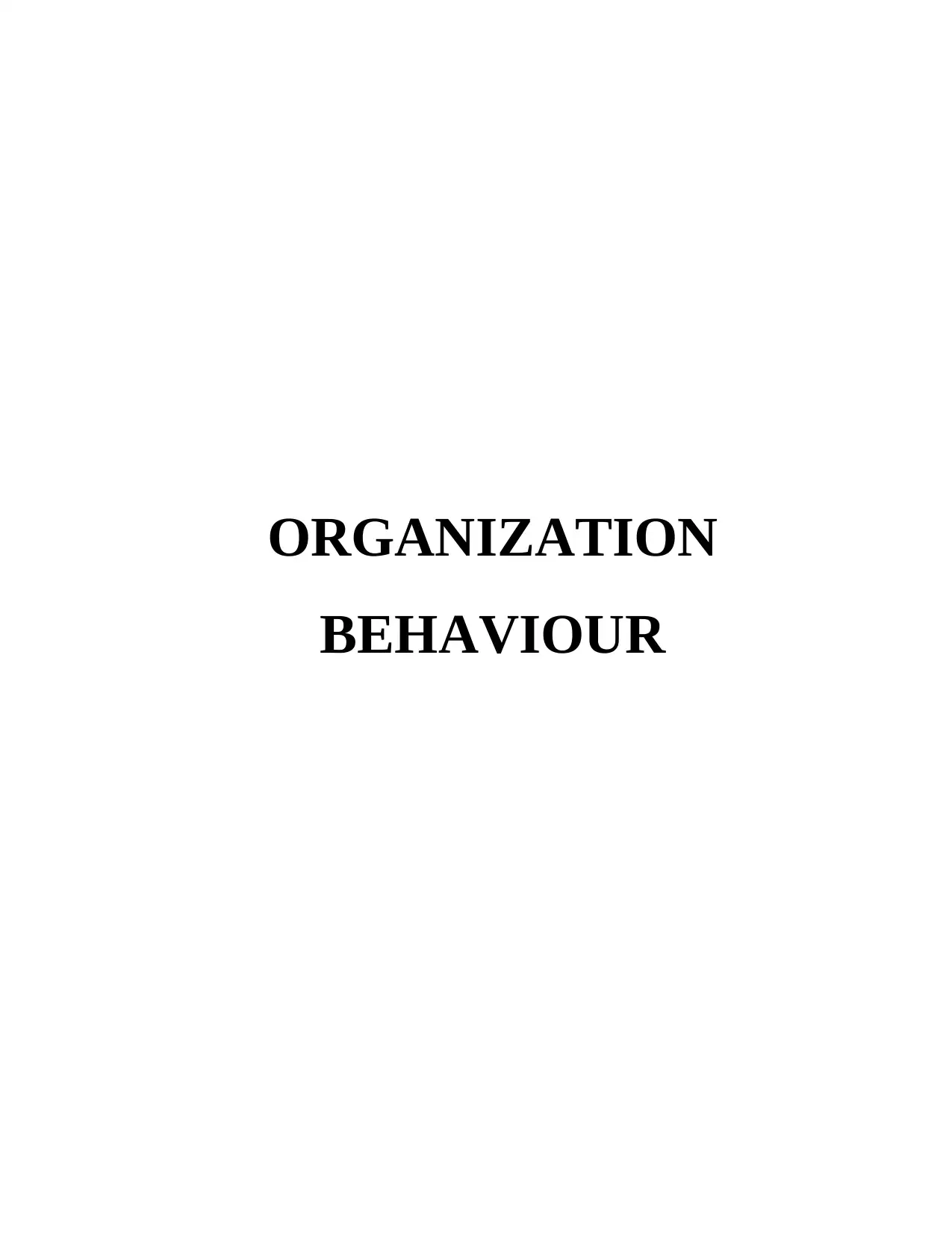
ORGANIZATION
BEHAVIOUR
BEHAVIOUR
Paraphrase This Document
Need a fresh take? Get an instant paraphrase of this document with our AI Paraphraser
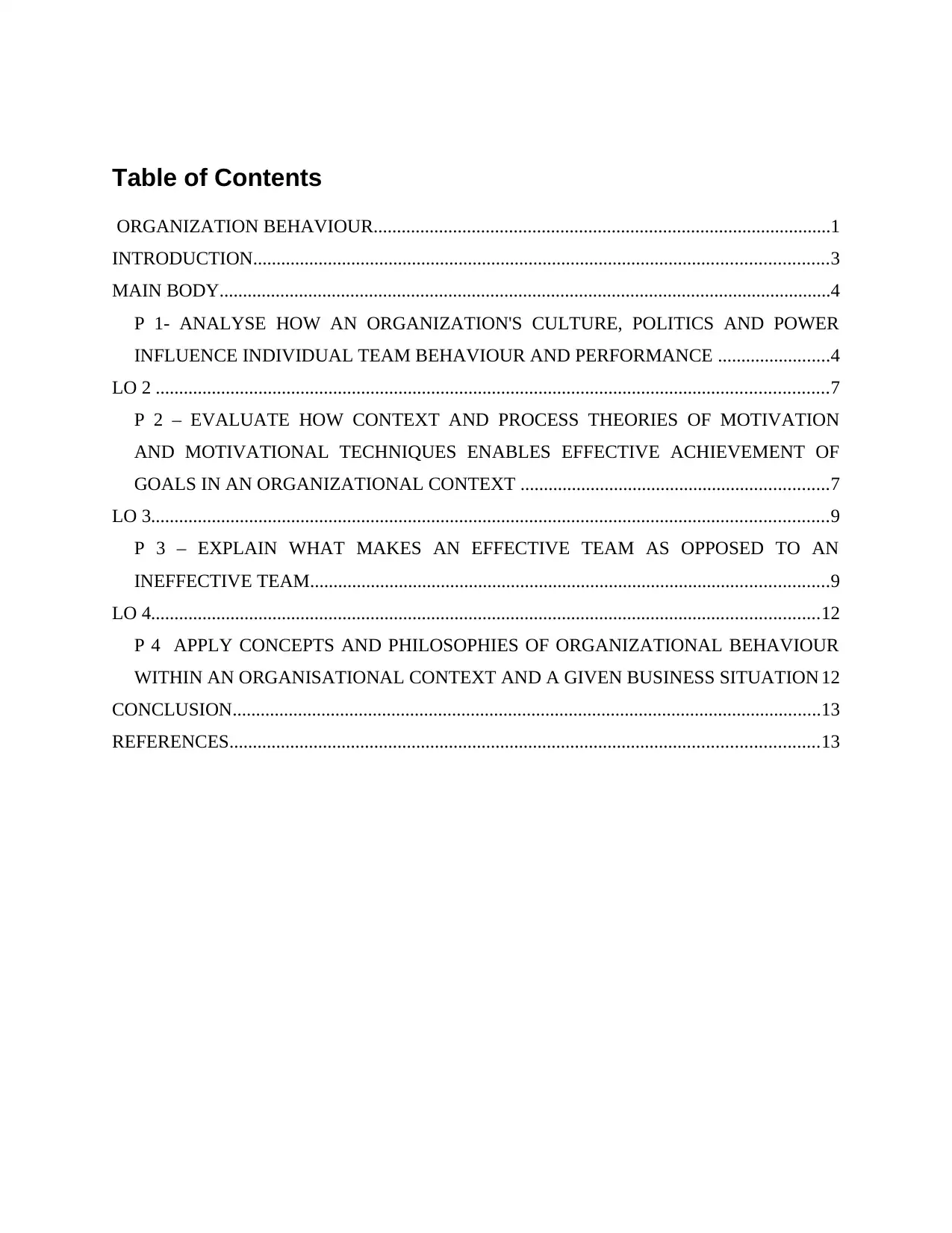
Table of Contents
ORGANIZATION BEHAVIOUR..................................................................................................1
INTRODUCTION...........................................................................................................................3
MAIN BODY...................................................................................................................................4
P 1- ANALYSE HOW AN ORGANIZATION'S CULTURE, POLITICS AND POWER
INFLUENCE INDIVIDUAL TEAM BEHAVIOUR AND PERFORMANCE ........................4
LO 2 ................................................................................................................................................7
P 2 – EVALUATE HOW CONTEXT AND PROCESS THEORIES OF MOTIVATION
AND MOTIVATIONAL TECHNIQUES ENABLES EFFECTIVE ACHIEVEMENT OF
GOALS IN AN ORGANIZATIONAL CONTEXT ..................................................................7
LO 3.................................................................................................................................................9
P 3 – EXPLAIN WHAT MAKES AN EFFECTIVE TEAM AS OPPOSED TO AN
INEFFECTIVE TEAM...............................................................................................................9
LO 4...............................................................................................................................................12
P 4 APPLY CONCEPTS AND PHILOSOPHIES OF ORGANIZATIONAL BEHAVIOUR
WITHIN AN ORGANISATIONAL CONTEXT AND A GIVEN BUSINESS SITUATION 12
CONCLUSION..............................................................................................................................13
REFERENCES..............................................................................................................................13
ORGANIZATION BEHAVIOUR..................................................................................................1
INTRODUCTION...........................................................................................................................3
MAIN BODY...................................................................................................................................4
P 1- ANALYSE HOW AN ORGANIZATION'S CULTURE, POLITICS AND POWER
INFLUENCE INDIVIDUAL TEAM BEHAVIOUR AND PERFORMANCE ........................4
LO 2 ................................................................................................................................................7
P 2 – EVALUATE HOW CONTEXT AND PROCESS THEORIES OF MOTIVATION
AND MOTIVATIONAL TECHNIQUES ENABLES EFFECTIVE ACHIEVEMENT OF
GOALS IN AN ORGANIZATIONAL CONTEXT ..................................................................7
LO 3.................................................................................................................................................9
P 3 – EXPLAIN WHAT MAKES AN EFFECTIVE TEAM AS OPPOSED TO AN
INEFFECTIVE TEAM...............................................................................................................9
LO 4...............................................................................................................................................12
P 4 APPLY CONCEPTS AND PHILOSOPHIES OF ORGANIZATIONAL BEHAVIOUR
WITHIN AN ORGANISATIONAL CONTEXT AND A GIVEN BUSINESS SITUATION 12
CONCLUSION..............................................................................................................................13
REFERENCES..............................................................................................................................13
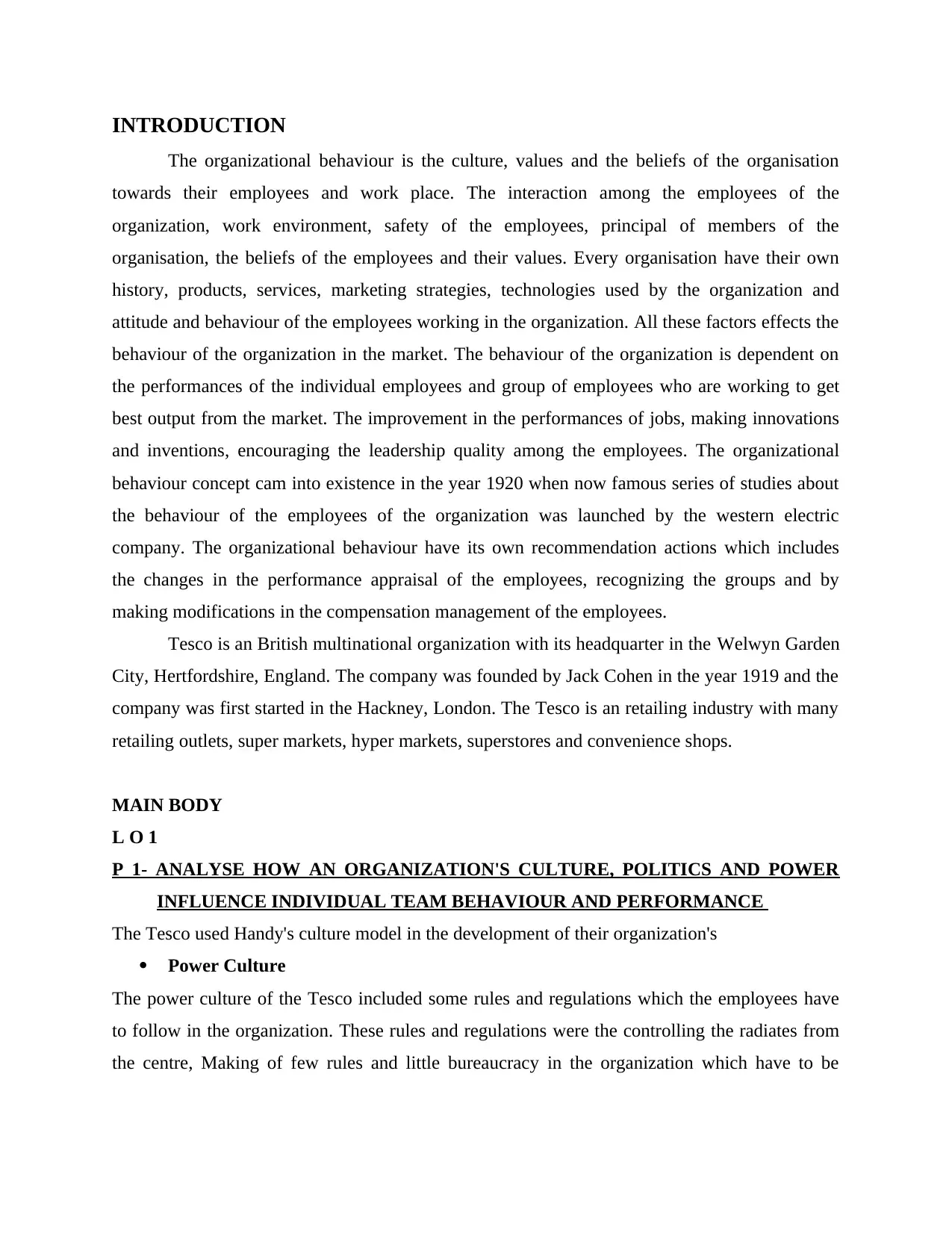
INTRODUCTION
The organizational behaviour is the culture, values and the beliefs of the organisation
towards their employees and work place. The interaction among the employees of the
organization, work environment, safety of the employees, principal of members of the
organisation, the beliefs of the employees and their values. Every organisation have their own
history, products, services, marketing strategies, technologies used by the organization and
attitude and behaviour of the employees working in the organization. All these factors effects the
behaviour of the organization in the market. The behaviour of the organization is dependent on
the performances of the individual employees and group of employees who are working to get
best output from the market. The improvement in the performances of jobs, making innovations
and inventions, encouraging the leadership quality among the employees. The organizational
behaviour concept cam into existence in the year 1920 when now famous series of studies about
the behaviour of the employees of the organization was launched by the western electric
company. The organizational behaviour have its own recommendation actions which includes
the changes in the performance appraisal of the employees, recognizing the groups and by
making modifications in the compensation management of the employees.
Tesco is an British multinational organization with its headquarter in the Welwyn Garden
City, Hertfordshire, England. The company was founded by Jack Cohen in the year 1919 and the
company was first started in the Hackney, London. The Tesco is an retailing industry with many
retailing outlets, super markets, hyper markets, superstores and convenience shops.
MAIN BODY
L O 1
P 1- ANALYSE HOW AN ORGANIZATION'S CULTURE, POLITICS AND POWER
INFLUENCE INDIVIDUAL TEAM BEHAVIOUR AND PERFORMANCE
The Tesco used Handy's culture model in the development of their organization's
Power Culture
The power culture of the Tesco included some rules and regulations which the employees have
to follow in the organization. These rules and regulations were the controlling the radiates from
the centre, Making of few rules and little bureaucracy in the organization which have to be
The organizational behaviour is the culture, values and the beliefs of the organisation
towards their employees and work place. The interaction among the employees of the
organization, work environment, safety of the employees, principal of members of the
organisation, the beliefs of the employees and their values. Every organisation have their own
history, products, services, marketing strategies, technologies used by the organization and
attitude and behaviour of the employees working in the organization. All these factors effects the
behaviour of the organization in the market. The behaviour of the organization is dependent on
the performances of the individual employees and group of employees who are working to get
best output from the market. The improvement in the performances of jobs, making innovations
and inventions, encouraging the leadership quality among the employees. The organizational
behaviour concept cam into existence in the year 1920 when now famous series of studies about
the behaviour of the employees of the organization was launched by the western electric
company. The organizational behaviour have its own recommendation actions which includes
the changes in the performance appraisal of the employees, recognizing the groups and by
making modifications in the compensation management of the employees.
Tesco is an British multinational organization with its headquarter in the Welwyn Garden
City, Hertfordshire, England. The company was founded by Jack Cohen in the year 1919 and the
company was first started in the Hackney, London. The Tesco is an retailing industry with many
retailing outlets, super markets, hyper markets, superstores and convenience shops.
MAIN BODY
L O 1
P 1- ANALYSE HOW AN ORGANIZATION'S CULTURE, POLITICS AND POWER
INFLUENCE INDIVIDUAL TEAM BEHAVIOUR AND PERFORMANCE
The Tesco used Handy's culture model in the development of their organization's
Power Culture
The power culture of the Tesco included some rules and regulations which the employees have
to follow in the organization. These rules and regulations were the controlling the radiates from
the centre, Making of few rules and little bureaucracy in the organization which have to be
⊘ This is a preview!⊘
Do you want full access?
Subscribe today to unlock all pages.

Trusted by 1+ million students worldwide
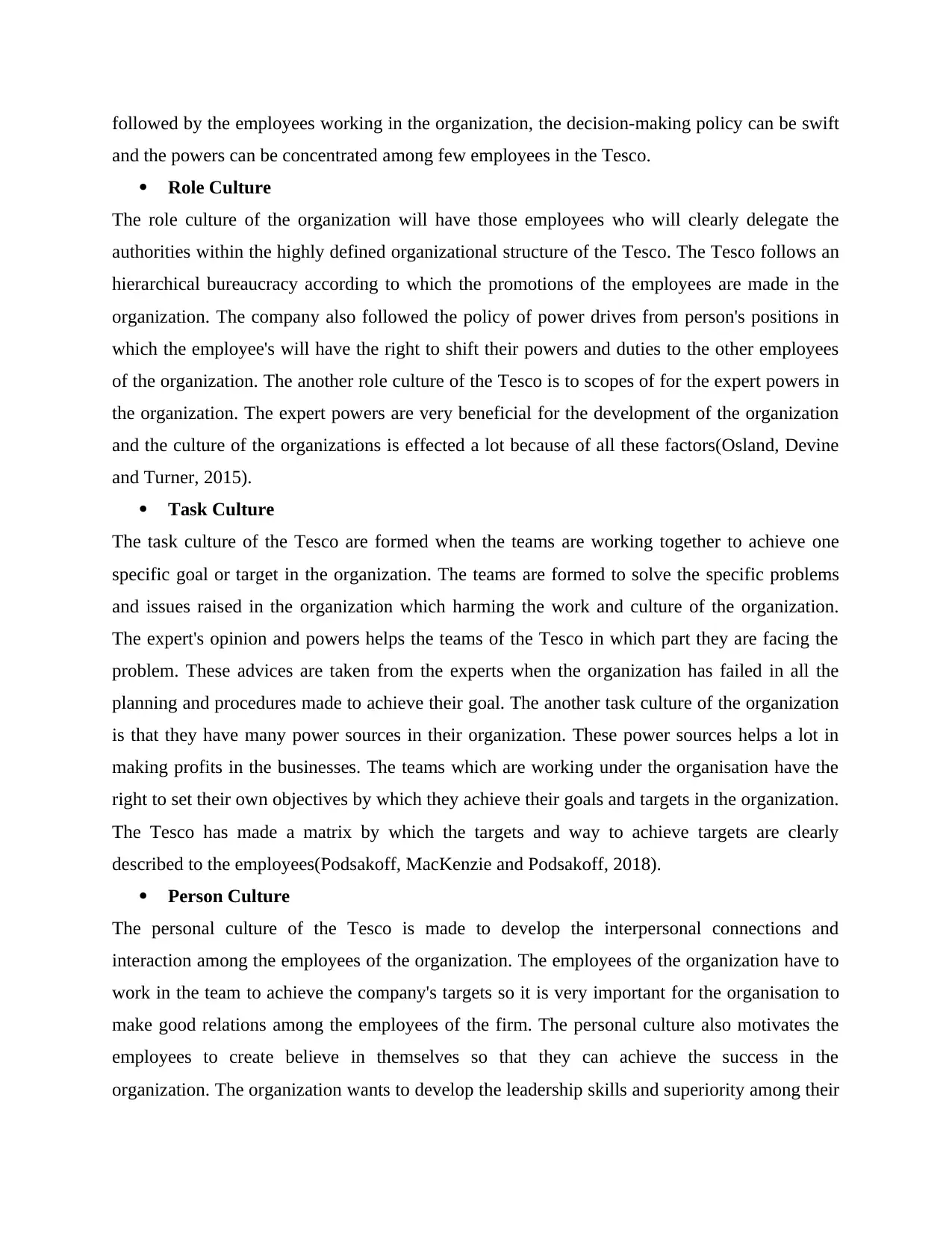
followed by the employees working in the organization, the decision-making policy can be swift
and the powers can be concentrated among few employees in the Tesco.
Role Culture
The role culture of the organization will have those employees who will clearly delegate the
authorities within the highly defined organizational structure of the Tesco. The Tesco follows an
hierarchical bureaucracy according to which the promotions of the employees are made in the
organization. The company also followed the policy of power drives from person's positions in
which the employee's will have the right to shift their powers and duties to the other employees
of the organization. The another role culture of the Tesco is to scopes of for the expert powers in
the organization. The expert powers are very beneficial for the development of the organization
and the culture of the organizations is effected a lot because of all these factors(Osland, Devine
and Turner, 2015).
Task Culture
The task culture of the Tesco are formed when the teams are working together to achieve one
specific goal or target in the organization. The teams are formed to solve the specific problems
and issues raised in the organization which harming the work and culture of the organization.
The expert's opinion and powers helps the teams of the Tesco in which part they are facing the
problem. These advices are taken from the experts when the organization has failed in all the
planning and procedures made to achieve their goal. The another task culture of the organization
is that they have many power sources in their organization. These power sources helps a lot in
making profits in the businesses. The teams which are working under the organisation have the
right to set their own objectives by which they achieve their goals and targets in the organization.
The Tesco has made a matrix by which the targets and way to achieve targets are clearly
described to the employees(Podsakoff, MacKenzie and Podsakoff, 2018).
Person Culture
The personal culture of the Tesco is made to develop the interpersonal connections and
interaction among the employees of the organization. The employees of the organization have to
work in the team to achieve the company's targets so it is very important for the organisation to
make good relations among the employees of the firm. The personal culture also motivates the
employees to create believe in themselves so that they can achieve the success in the
organization. The organization wants to develop the leadership skills and superiority among their
and the powers can be concentrated among few employees in the Tesco.
Role Culture
The role culture of the organization will have those employees who will clearly delegate the
authorities within the highly defined organizational structure of the Tesco. The Tesco follows an
hierarchical bureaucracy according to which the promotions of the employees are made in the
organization. The company also followed the policy of power drives from person's positions in
which the employee's will have the right to shift their powers and duties to the other employees
of the organization. The another role culture of the Tesco is to scopes of for the expert powers in
the organization. The expert powers are very beneficial for the development of the organization
and the culture of the organizations is effected a lot because of all these factors(Osland, Devine
and Turner, 2015).
Task Culture
The task culture of the Tesco are formed when the teams are working together to achieve one
specific goal or target in the organization. The teams are formed to solve the specific problems
and issues raised in the organization which harming the work and culture of the organization.
The expert's opinion and powers helps the teams of the Tesco in which part they are facing the
problem. These advices are taken from the experts when the organization has failed in all the
planning and procedures made to achieve their goal. The another task culture of the organization
is that they have many power sources in their organization. These power sources helps a lot in
making profits in the businesses. The teams which are working under the organisation have the
right to set their own objectives by which they achieve their goals and targets in the organization.
The Tesco has made a matrix by which the targets and way to achieve targets are clearly
described to the employees(Podsakoff, MacKenzie and Podsakoff, 2018).
Person Culture
The personal culture of the Tesco is made to develop the interpersonal connections and
interaction among the employees of the organization. The employees of the organization have to
work in the team to achieve the company's targets so it is very important for the organisation to
make good relations among the employees of the firm. The personal culture also motivates the
employees to create believe in themselves so that they can achieve the success in the
organization. The organization wants to develop the leadership skills and superiority among their
Paraphrase This Document
Need a fresh take? Get an instant paraphrase of this document with our AI Paraphraser
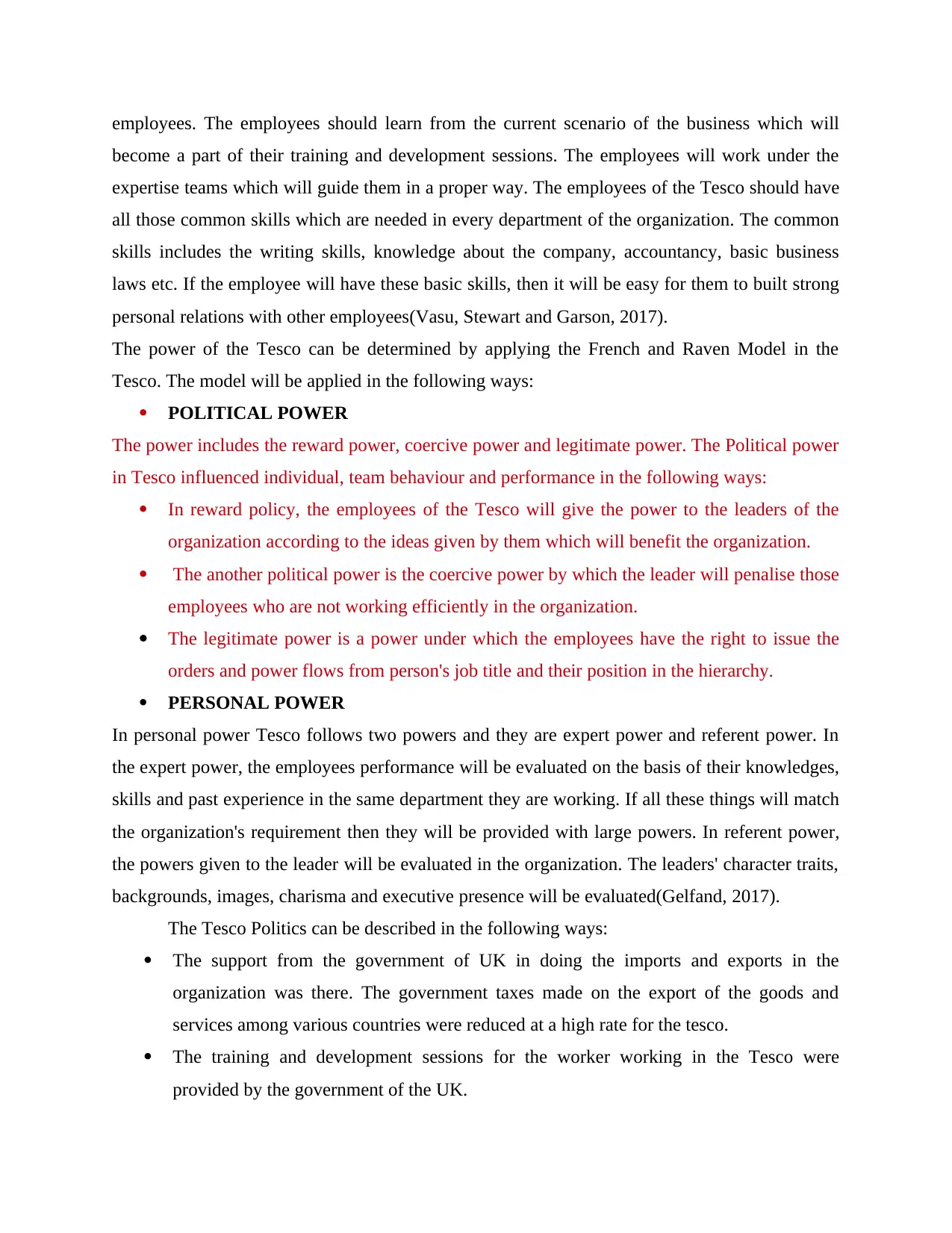
employees. The employees should learn from the current scenario of the business which will
become a part of their training and development sessions. The employees will work under the
expertise teams which will guide them in a proper way. The employees of the Tesco should have
all those common skills which are needed in every department of the organization. The common
skills includes the writing skills, knowledge about the company, accountancy, basic business
laws etc. If the employee will have these basic skills, then it will be easy for them to built strong
personal relations with other employees(Vasu, Stewart and Garson, 2017).
The power of the Tesco can be determined by applying the French and Raven Model in the
Tesco. The model will be applied in the following ways:
POLITICAL POWER
The power includes the reward power, coercive power and legitimate power. The Political power
in Tesco influenced individual, team behaviour and performance in the following ways:
In reward policy, the employees of the Tesco will give the power to the leaders of the
organization according to the ideas given by them which will benefit the organization.
The another political power is the coercive power by which the leader will penalise those
employees who are not working efficiently in the organization.
The legitimate power is a power under which the employees have the right to issue the
orders and power flows from person's job title and their position in the hierarchy.
PERSONAL POWER
In personal power Tesco follows two powers and they are expert power and referent power. In
the expert power, the employees performance will be evaluated on the basis of their knowledges,
skills and past experience in the same department they are working. If all these things will match
the organization's requirement then they will be provided with large powers. In referent power,
the powers given to the leader will be evaluated in the organization. The leaders' character traits,
backgrounds, images, charisma and executive presence will be evaluated(Gelfand, 2017).
The Tesco Politics can be described in the following ways:
The support from the government of UK in doing the imports and exports in the
organization was there. The government taxes made on the export of the goods and
services among various countries were reduced at a high rate for the tesco.
The training and development sessions for the worker working in the Tesco were
provided by the government of the UK.
become a part of their training and development sessions. The employees will work under the
expertise teams which will guide them in a proper way. The employees of the Tesco should have
all those common skills which are needed in every department of the organization. The common
skills includes the writing skills, knowledge about the company, accountancy, basic business
laws etc. If the employee will have these basic skills, then it will be easy for them to built strong
personal relations with other employees(Vasu, Stewart and Garson, 2017).
The power of the Tesco can be determined by applying the French and Raven Model in the
Tesco. The model will be applied in the following ways:
POLITICAL POWER
The power includes the reward power, coercive power and legitimate power. The Political power
in Tesco influenced individual, team behaviour and performance in the following ways:
In reward policy, the employees of the Tesco will give the power to the leaders of the
organization according to the ideas given by them which will benefit the organization.
The another political power is the coercive power by which the leader will penalise those
employees who are not working efficiently in the organization.
The legitimate power is a power under which the employees have the right to issue the
orders and power flows from person's job title and their position in the hierarchy.
PERSONAL POWER
In personal power Tesco follows two powers and they are expert power and referent power. In
the expert power, the employees performance will be evaluated on the basis of their knowledges,
skills and past experience in the same department they are working. If all these things will match
the organization's requirement then they will be provided with large powers. In referent power,
the powers given to the leader will be evaluated in the organization. The leaders' character traits,
backgrounds, images, charisma and executive presence will be evaluated(Gelfand, 2017).
The Tesco Politics can be described in the following ways:
The support from the government of UK in doing the imports and exports in the
organization was there. The government taxes made on the export of the goods and
services among various countries were reduced at a high rate for the tesco.
The training and development sessions for the worker working in the Tesco were
provided by the government of the UK.
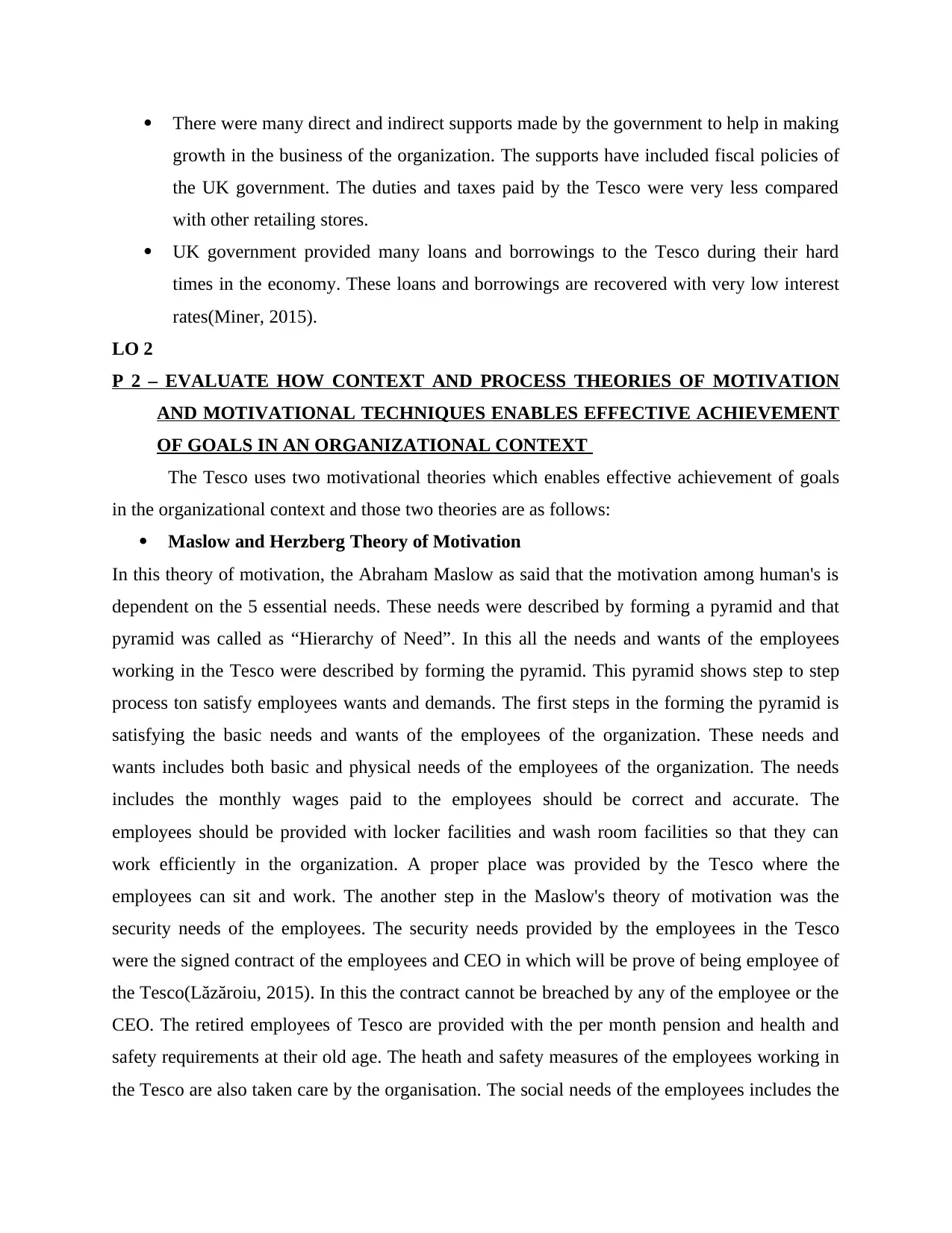
There were many direct and indirect supports made by the government to help in making
growth in the business of the organization. The supports have included fiscal policies of
the UK government. The duties and taxes paid by the Tesco were very less compared
with other retailing stores.
UK government provided many loans and borrowings to the Tesco during their hard
times in the economy. These loans and borrowings are recovered with very low interest
rates(Miner, 2015).
LO 2
P 2 – EVALUATE HOW CONTEXT AND PROCESS THEORIES OF MOTIVATION
AND MOTIVATIONAL TECHNIQUES ENABLES EFFECTIVE ACHIEVEMENT
OF GOALS IN AN ORGANIZATIONAL CONTEXT
The Tesco uses two motivational theories which enables effective achievement of goals
in the organizational context and those two theories are as follows:
Maslow and Herzberg Theory of Motivation
In this theory of motivation, the Abraham Maslow as said that the motivation among human's is
dependent on the 5 essential needs. These needs were described by forming a pyramid and that
pyramid was called as “Hierarchy of Need”. In this all the needs and wants of the employees
working in the Tesco were described by forming the pyramid. This pyramid shows step to step
process ton satisfy employees wants and demands. The first steps in the forming the pyramid is
satisfying the basic needs and wants of the employees of the organization. These needs and
wants includes both basic and physical needs of the employees of the organization. The needs
includes the monthly wages paid to the employees should be correct and accurate. The
employees should be provided with locker facilities and wash room facilities so that they can
work efficiently in the organization. A proper place was provided by the Tesco where the
employees can sit and work. The another step in the Maslow's theory of motivation was the
security needs of the employees. The security needs provided by the employees in the Tesco
were the signed contract of the employees and CEO in which will be prove of being employee of
the Tesco(Lăzăroiu, 2015). In this the contract cannot be breached by any of the employee or the
CEO. The retired employees of Tesco are provided with the per month pension and health and
safety requirements at their old age. The heath and safety measures of the employees working in
the Tesco are also taken care by the organisation. The social needs of the employees includes the
growth in the business of the organization. The supports have included fiscal policies of
the UK government. The duties and taxes paid by the Tesco were very less compared
with other retailing stores.
UK government provided many loans and borrowings to the Tesco during their hard
times in the economy. These loans and borrowings are recovered with very low interest
rates(Miner, 2015).
LO 2
P 2 – EVALUATE HOW CONTEXT AND PROCESS THEORIES OF MOTIVATION
AND MOTIVATIONAL TECHNIQUES ENABLES EFFECTIVE ACHIEVEMENT
OF GOALS IN AN ORGANIZATIONAL CONTEXT
The Tesco uses two motivational theories which enables effective achievement of goals
in the organizational context and those two theories are as follows:
Maslow and Herzberg Theory of Motivation
In this theory of motivation, the Abraham Maslow as said that the motivation among human's is
dependent on the 5 essential needs. These needs were described by forming a pyramid and that
pyramid was called as “Hierarchy of Need”. In this all the needs and wants of the employees
working in the Tesco were described by forming the pyramid. This pyramid shows step to step
process ton satisfy employees wants and demands. The first steps in the forming the pyramid is
satisfying the basic needs and wants of the employees of the organization. These needs and
wants includes both basic and physical needs of the employees of the organization. The needs
includes the monthly wages paid to the employees should be correct and accurate. The
employees should be provided with locker facilities and wash room facilities so that they can
work efficiently in the organization. A proper place was provided by the Tesco where the
employees can sit and work. The another step in the Maslow's theory of motivation was the
security needs of the employees. The security needs provided by the employees in the Tesco
were the signed contract of the employees and CEO in which will be prove of being employee of
the Tesco(Lăzăroiu, 2015). In this the contract cannot be breached by any of the employee or the
CEO. The retired employees of Tesco are provided with the per month pension and health and
safety requirements at their old age. The heath and safety measures of the employees working in
the Tesco are also taken care by the organisation. The social needs of the employees includes the
⊘ This is a preview!⊘
Do you want full access?
Subscribe today to unlock all pages.

Trusted by 1+ million students worldwide

team and group works made in the Tesco for their employees. These “steering wheel” policy
used in the Tesco has encouraged the employees to work in a team in the retailing outlets and
provide long term services to their employees. The another step in the “hierarchy of needs” is
the self esteem of the employees of the organization. In this the employees of Tesco motivates
the employees to create self respect and respect for other employees of the organization for their
hard work and efforts. The employees are provided with the self assessments, performance
appraisal and 360 degree feedback in the Tesco by which the employees will contribute more in
making the output and will be helpful in recognizing the performance of every individual. The
final step of this model is the self fulfilment in the Tesco. In this the organization provides the
career progression programme, opportunity for promotions, recognitions of skills and talents and
personal development plans for the employees of the Tesco(Kinicki and Fugate, 2017).
Vroom's Expectancy Theory of Motivation
The Vroom's expectancy theory of motivation used in the Tesco is based on the motive of
“maximizing the pleasure and minimizing the pain” of the employees of the Tesco. The Vroom
has said that the performance of the employees is based on the individual factors which effects
the performances of the employees in the organization. The factors which are involved in the
Vroom's expectancy theory are the skills, knowledges, practices, personality, abilities and
experiences. The employees of Tesco should have all these factors so that the organization can
achieve success and growth. The Vroom;s Expectancy Theory includes the expectancy,
instrumentality and valence. In the expectancy, the Tesco has believed that if the work will be
done in efficient manner then the business will automatically grow in the market. The amount of
efforts putted by each employee of the organization will result in the final result of the Tesco
growth in the market. The things which affects the expectancy theory are the right resources
available to the employee's of the organization, right skilled employees are recruited in the
organization who can use their knowledges in the task provided to them and right to have all
necessary supports in the Tesco. The Instrumentality of the Tesco in which the employees were
motivated by saying that if they will perform well in the organization, then they will produce the
outcome which will be valued in the market. The employees of the Tesco should clearly
understand the relationship between the tasks performed by them and output received to the
organization. If they both will be considered effective for the business then the employees will be
provided with benefits. The trust among the other employee's who is taking decision about
used in the Tesco has encouraged the employees to work in a team in the retailing outlets and
provide long term services to their employees. The another step in the “hierarchy of needs” is
the self esteem of the employees of the organization. In this the employees of Tesco motivates
the employees to create self respect and respect for other employees of the organization for their
hard work and efforts. The employees are provided with the self assessments, performance
appraisal and 360 degree feedback in the Tesco by which the employees will contribute more in
making the output and will be helpful in recognizing the performance of every individual. The
final step of this model is the self fulfilment in the Tesco. In this the organization provides the
career progression programme, opportunity for promotions, recognitions of skills and talents and
personal development plans for the employees of the Tesco(Kinicki and Fugate, 2017).
Vroom's Expectancy Theory of Motivation
The Vroom's expectancy theory of motivation used in the Tesco is based on the motive of
“maximizing the pleasure and minimizing the pain” of the employees of the Tesco. The Vroom
has said that the performance of the employees is based on the individual factors which effects
the performances of the employees in the organization. The factors which are involved in the
Vroom's expectancy theory are the skills, knowledges, practices, personality, abilities and
experiences. The employees of Tesco should have all these factors so that the organization can
achieve success and growth. The Vroom;s Expectancy Theory includes the expectancy,
instrumentality and valence. In the expectancy, the Tesco has believed that if the work will be
done in efficient manner then the business will automatically grow in the market. The amount of
efforts putted by each employee of the organization will result in the final result of the Tesco
growth in the market. The things which affects the expectancy theory are the right resources
available to the employee's of the organization, right skilled employees are recruited in the
organization who can use their knowledges in the task provided to them and right to have all
necessary supports in the Tesco. The Instrumentality of the Tesco in which the employees were
motivated by saying that if they will perform well in the organization, then they will produce the
outcome which will be valued in the market. The employees of the Tesco should clearly
understand the relationship between the tasks performed by them and output received to the
organization. If they both will be considered effective for the business then the employees will be
provided with benefits. The trust among the other employee's who is taking decision about
Paraphrase This Document
Need a fresh take? Get an instant paraphrase of this document with our AI Paraphraser
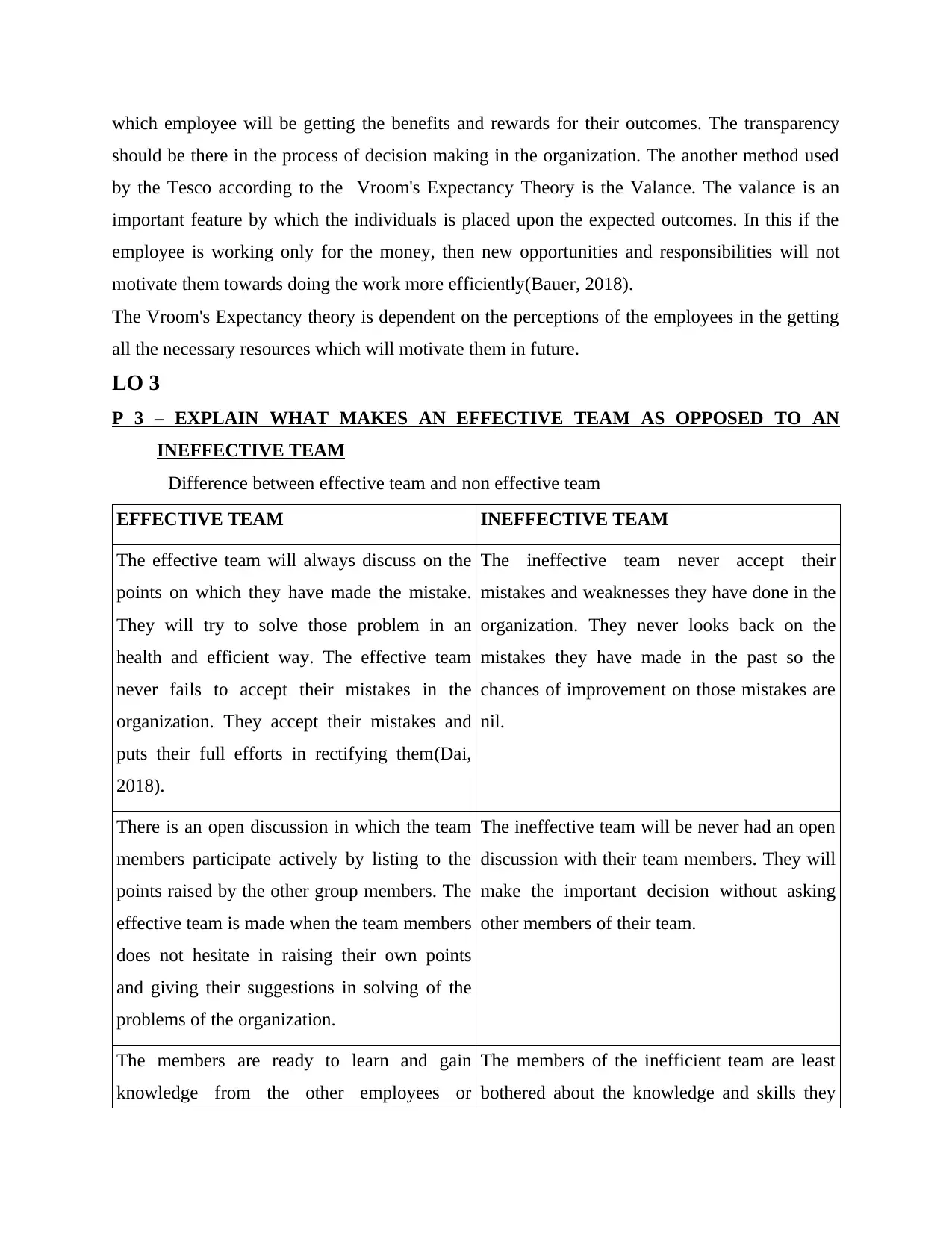
which employee will be getting the benefits and rewards for their outcomes. The transparency
should be there in the process of decision making in the organization. The another method used
by the Tesco according to the Vroom's Expectancy Theory is the Valance. The valance is an
important feature by which the individuals is placed upon the expected outcomes. In this if the
employee is working only for the money, then new opportunities and responsibilities will not
motivate them towards doing the work more efficiently(Bauer, 2018).
The Vroom's Expectancy theory is dependent on the perceptions of the employees in the getting
all the necessary resources which will motivate them in future.
LO 3
P 3 – EXPLAIN WHAT MAKES AN EFFECTIVE TEAM AS OPPOSED TO AN
INEFFECTIVE TEAM
Difference between effective team and non effective team
EFFECTIVE TEAM INEFFECTIVE TEAM
The effective team will always discuss on the
points on which they have made the mistake.
They will try to solve those problem in an
health and efficient way. The effective team
never fails to accept their mistakes in the
organization. They accept their mistakes and
puts their full efforts in rectifying them(Dai,
2018).
The ineffective team never accept their
mistakes and weaknesses they have done in the
organization. They never looks back on the
mistakes they have made in the past so the
chances of improvement on those mistakes are
nil.
There is an open discussion in which the team
members participate actively by listing to the
points raised by the other group members. The
effective team is made when the team members
does not hesitate in raising their own points
and giving their suggestions in solving of the
problems of the organization.
The ineffective team will be never had an open
discussion with their team members. They will
make the important decision without asking
other members of their team.
The members are ready to learn and gain
knowledge from the other employees or
The members of the inefficient team are least
bothered about the knowledge and skills they
should be there in the process of decision making in the organization. The another method used
by the Tesco according to the Vroom's Expectancy Theory is the Valance. The valance is an
important feature by which the individuals is placed upon the expected outcomes. In this if the
employee is working only for the money, then new opportunities and responsibilities will not
motivate them towards doing the work more efficiently(Bauer, 2018).
The Vroom's Expectancy theory is dependent on the perceptions of the employees in the getting
all the necessary resources which will motivate them in future.
LO 3
P 3 – EXPLAIN WHAT MAKES AN EFFECTIVE TEAM AS OPPOSED TO AN
INEFFECTIVE TEAM
Difference between effective team and non effective team
EFFECTIVE TEAM INEFFECTIVE TEAM
The effective team will always discuss on the
points on which they have made the mistake.
They will try to solve those problem in an
health and efficient way. The effective team
never fails to accept their mistakes in the
organization. They accept their mistakes and
puts their full efforts in rectifying them(Dai,
2018).
The ineffective team never accept their
mistakes and weaknesses they have done in the
organization. They never looks back on the
mistakes they have made in the past so the
chances of improvement on those mistakes are
nil.
There is an open discussion in which the team
members participate actively by listing to the
points raised by the other group members. The
effective team is made when the team members
does not hesitate in raising their own points
and giving their suggestions in solving of the
problems of the organization.
The ineffective team will be never had an open
discussion with their team members. They will
make the important decision without asking
other members of their team.
The members are ready to learn and gain
knowledge from the other employees or
The members of the inefficient team are least
bothered about the knowledge and skills they
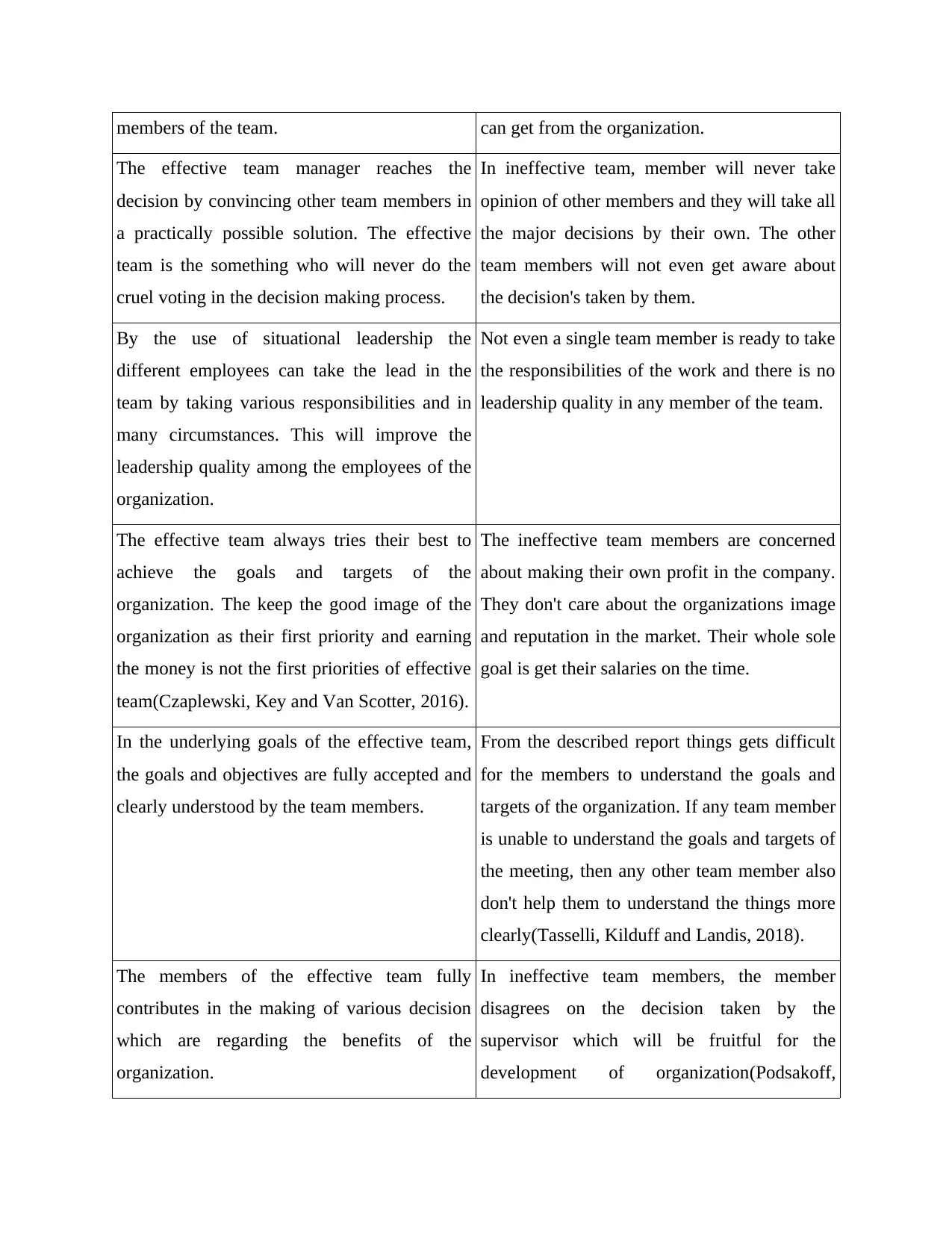
members of the team. can get from the organization.
The effective team manager reaches the
decision by convincing other team members in
a practically possible solution. The effective
team is the something who will never do the
cruel voting in the decision making process.
In ineffective team, member will never take
opinion of other members and they will take all
the major decisions by their own. The other
team members will not even get aware about
the decision's taken by them.
By the use of situational leadership the
different employees can take the lead in the
team by taking various responsibilities and in
many circumstances. This will improve the
leadership quality among the employees of the
organization.
Not even a single team member is ready to take
the responsibilities of the work and there is no
leadership quality in any member of the team.
The effective team always tries their best to
achieve the goals and targets of the
organization. The keep the good image of the
organization as their first priority and earning
the money is not the first priorities of effective
team(Czaplewski, Key and Van Scotter, 2016).
The ineffective team members are concerned
about making their own profit in the company.
They don't care about the organizations image
and reputation in the market. Their whole sole
goal is get their salaries on the time.
In the underlying goals of the effective team,
the goals and objectives are fully accepted and
clearly understood by the team members.
From the described report things gets difficult
for the members to understand the goals and
targets of the organization. If any team member
is unable to understand the goals and targets of
the meeting, then any other team member also
don't help them to understand the things more
clearly(Tasselli, Kilduff and Landis, 2018).
The members of the effective team fully
contributes in the making of various decision
which are regarding the benefits of the
organization.
In ineffective team members, the member
disagrees on the decision taken by the
supervisor which will be fruitful for the
development of organization(Podsakoff,
The effective team manager reaches the
decision by convincing other team members in
a practically possible solution. The effective
team is the something who will never do the
cruel voting in the decision making process.
In ineffective team, member will never take
opinion of other members and they will take all
the major decisions by their own. The other
team members will not even get aware about
the decision's taken by them.
By the use of situational leadership the
different employees can take the lead in the
team by taking various responsibilities and in
many circumstances. This will improve the
leadership quality among the employees of the
organization.
Not even a single team member is ready to take
the responsibilities of the work and there is no
leadership quality in any member of the team.
The effective team always tries their best to
achieve the goals and targets of the
organization. The keep the good image of the
organization as their first priority and earning
the money is not the first priorities of effective
team(Czaplewski, Key and Van Scotter, 2016).
The ineffective team members are concerned
about making their own profit in the company.
They don't care about the organizations image
and reputation in the market. Their whole sole
goal is get their salaries on the time.
In the underlying goals of the effective team,
the goals and objectives are fully accepted and
clearly understood by the team members.
From the described report things gets difficult
for the members to understand the goals and
targets of the organization. If any team member
is unable to understand the goals and targets of
the meeting, then any other team member also
don't help them to understand the things more
clearly(Tasselli, Kilduff and Landis, 2018).
The members of the effective team fully
contributes in the making of various decision
which are regarding the benefits of the
organization.
In ineffective team members, the member
disagrees on the decision taken by the
supervisor which will be fruitful for the
development of organization(Podsakoff,
⊘ This is a preview!⊘
Do you want full access?
Subscribe today to unlock all pages.

Trusted by 1+ million students worldwide
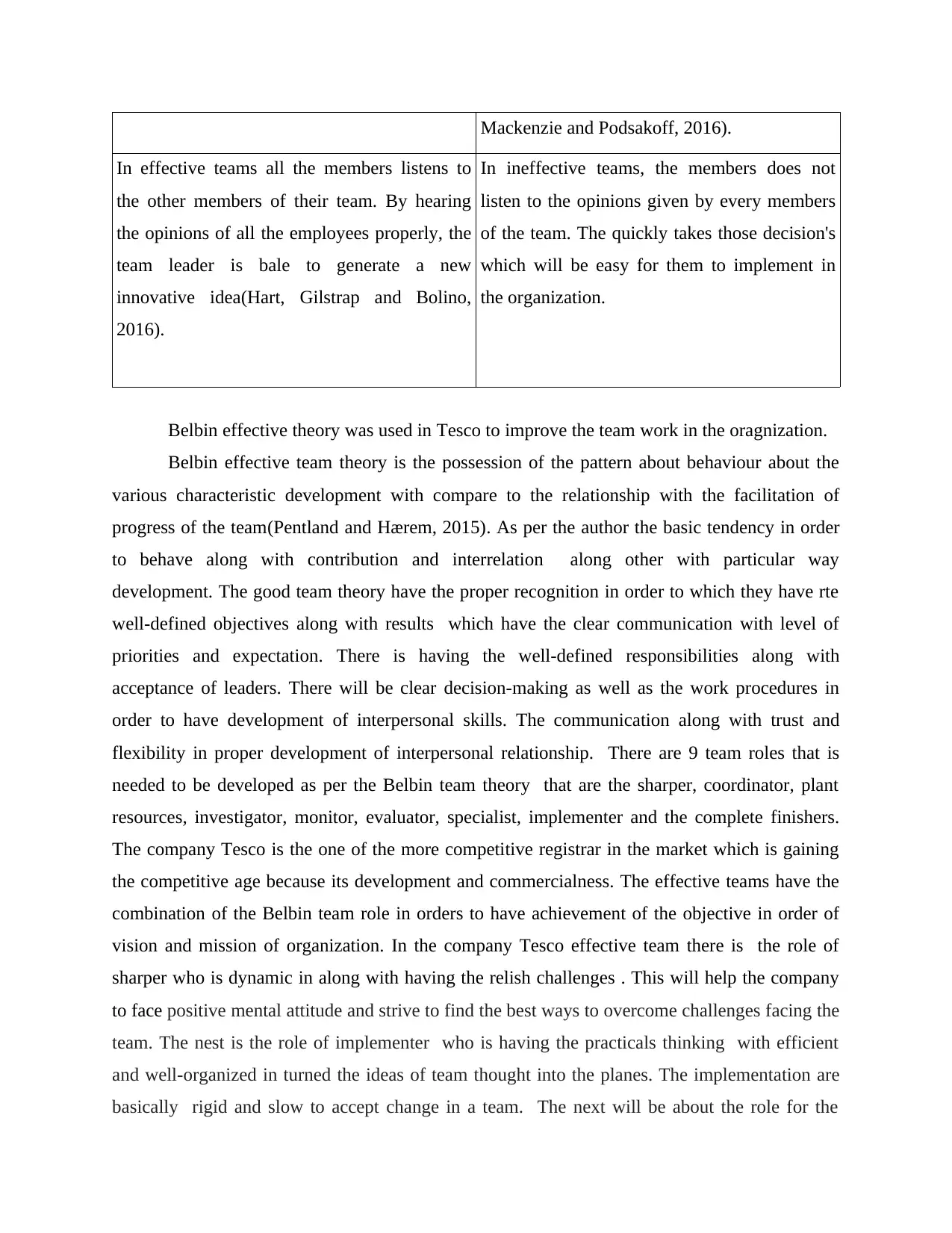
Mackenzie and Podsakoff, 2016).
In effective teams all the members listens to
the other members of their team. By hearing
the opinions of all the employees properly, the
team leader is bale to generate a new
innovative idea(Hart, Gilstrap and Bolino,
2016).
In ineffective teams, the members does not
listen to the opinions given by every members
of the team. The quickly takes those decision's
which will be easy for them to implement in
the organization.
Belbin effective theory was used in Tesco to improve the team work in the oragnization.
Belbin effective team theory is the possession of the pattern about behaviour about the
various characteristic development with compare to the relationship with the facilitation of
progress of the team(Pentland and Hærem, 2015). As per the author the basic tendency in order
to behave along with contribution and interrelation along other with particular way
development. The good team theory have the proper recognition in order to which they have rte
well-defined objectives along with results which have the clear communication with level of
priorities and expectation. There is having the well-defined responsibilities along with
acceptance of leaders. There will be clear decision-making as well as the work procedures in
order to have development of interpersonal skills. The communication along with trust and
flexibility in proper development of interpersonal relationship. There are 9 team roles that is
needed to be developed as per the Belbin team theory that are the sharper, coordinator, plant
resources, investigator, monitor, evaluator, specialist, implementer and the complete finishers.
The company Tesco is the one of the more competitive registrar in the market which is gaining
the competitive age because its development and commercialness. The effective teams have the
combination of the Belbin team role in orders to have achievement of the objective in order of
vision and mission of organization. In the company Tesco effective team there is the role of
sharper who is dynamic in along with having the relish challenges . This will help the company
to face positive mental attitude and strive to find the best ways to overcome challenges facing the
team. The nest is the role of implementer who is having the practicals thinking with efficient
and well-organized in turned the ideas of team thought into the planes. The implementation are
basically rigid and slow to accept change in a team. The next will be about the role for the
In effective teams all the members listens to
the other members of their team. By hearing
the opinions of all the employees properly, the
team leader is bale to generate a new
innovative idea(Hart, Gilstrap and Bolino,
2016).
In ineffective teams, the members does not
listen to the opinions given by every members
of the team. The quickly takes those decision's
which will be easy for them to implement in
the organization.
Belbin effective theory was used in Tesco to improve the team work in the oragnization.
Belbin effective team theory is the possession of the pattern about behaviour about the
various characteristic development with compare to the relationship with the facilitation of
progress of the team(Pentland and Hærem, 2015). As per the author the basic tendency in order
to behave along with contribution and interrelation along other with particular way
development. The good team theory have the proper recognition in order to which they have rte
well-defined objectives along with results which have the clear communication with level of
priorities and expectation. There is having the well-defined responsibilities along with
acceptance of leaders. There will be clear decision-making as well as the work procedures in
order to have development of interpersonal skills. The communication along with trust and
flexibility in proper development of interpersonal relationship. There are 9 team roles that is
needed to be developed as per the Belbin team theory that are the sharper, coordinator, plant
resources, investigator, monitor, evaluator, specialist, implementer and the complete finishers.
The company Tesco is the one of the more competitive registrar in the market which is gaining
the competitive age because its development and commercialness. The effective teams have the
combination of the Belbin team role in orders to have achievement of the objective in order of
vision and mission of organization. In the company Tesco effective team there is the role of
sharper who is dynamic in along with having the relish challenges . This will help the company
to face positive mental attitude and strive to find the best ways to overcome challenges facing the
team. The nest is the role of implementer who is having the practicals thinking with efficient
and well-organized in turned the ideas of team thought into the planes. The implementation are
basically rigid and slow to accept change in a team. The next will be about the role for the
Paraphrase This Document
Need a fresh take? Get an instant paraphrase of this document with our AI Paraphraser

investigator who is inquisitive and enthusiastic in nature and possess great negotiating and
networking skills(Newman, 2017). They are extroverts, which makes it easy for others to relate
to them.
LO 4
P 4 APPLY CONCEPTS AND PHILOSOPHIES OF ORGANIZATIONAL BEHAVIOUR
WITHIN AN ORGANISATIONAL CONTEXT AND A GIVEN BUSINESS
SITUATION
ORGANISATIONAL PHILOSOPHIES OF TESCO
Vision
The Tesco wanted a growing business which is full of opportunities for the employees working
in the organization. The organization was using the modern technologies which were full of
innovations and ideas. The organisation wants to earn the trust and loyalty of their customers.
Mission
The mission of the organization was “we make what matters better together”. The organization's
mission was to achieve their goals and targets on the time. The key roles of the organisation must
be followed by each and every employee on time and the strategies used to expand the business
must be innovative.
Core Values
The core values of the organization were to be the zero carbon business in the environment will
be protected and the more and more customers will get attracted towards their product. The core
values of the Tesco involved the loyalty of their customer and to give best business in the UK
economy.
Path goal theory refers to the style best and effective style of the leader for the employees
and the working atmosphere of the business. Style and behaviour of the leader towards the
employees of the company must be effective and efficient to achieve the success and the growth
of the business. The main aim of the path goal theory is to increase the level of motivation and
satisfaction in the employees so that they become the effective and efficient employees of the
company. In the path goal theory there are the four style of the leadership which increase the
performance of the employees and also increase the productivity of the TESCO in the different
situation of the markets. In the directive style of the leadership the leader gives the instructions to
the employees of the TESCO and let them know about what is the expectation of them. Leader of
networking skills(Newman, 2017). They are extroverts, which makes it easy for others to relate
to them.
LO 4
P 4 APPLY CONCEPTS AND PHILOSOPHIES OF ORGANIZATIONAL BEHAVIOUR
WITHIN AN ORGANISATIONAL CONTEXT AND A GIVEN BUSINESS
SITUATION
ORGANISATIONAL PHILOSOPHIES OF TESCO
Vision
The Tesco wanted a growing business which is full of opportunities for the employees working
in the organization. The organization was using the modern technologies which were full of
innovations and ideas. The organisation wants to earn the trust and loyalty of their customers.
Mission
The mission of the organization was “we make what matters better together”. The organization's
mission was to achieve their goals and targets on the time. The key roles of the organisation must
be followed by each and every employee on time and the strategies used to expand the business
must be innovative.
Core Values
The core values of the organization were to be the zero carbon business in the environment will
be protected and the more and more customers will get attracted towards their product. The core
values of the Tesco involved the loyalty of their customer and to give best business in the UK
economy.
Path goal theory refers to the style best and effective style of the leader for the employees
and the working atmosphere of the business. Style and behaviour of the leader towards the
employees of the company must be effective and efficient to achieve the success and the growth
of the business. The main aim of the path goal theory is to increase the level of motivation and
satisfaction in the employees so that they become the effective and efficient employees of the
company. In the path goal theory there are the four style of the leadership which increase the
performance of the employees and also increase the productivity of the TESCO in the different
situation of the markets. In the directive style of the leadership the leader gives the instructions to
the employees of the TESCO and let them know about what is the expectation of them. Leader of
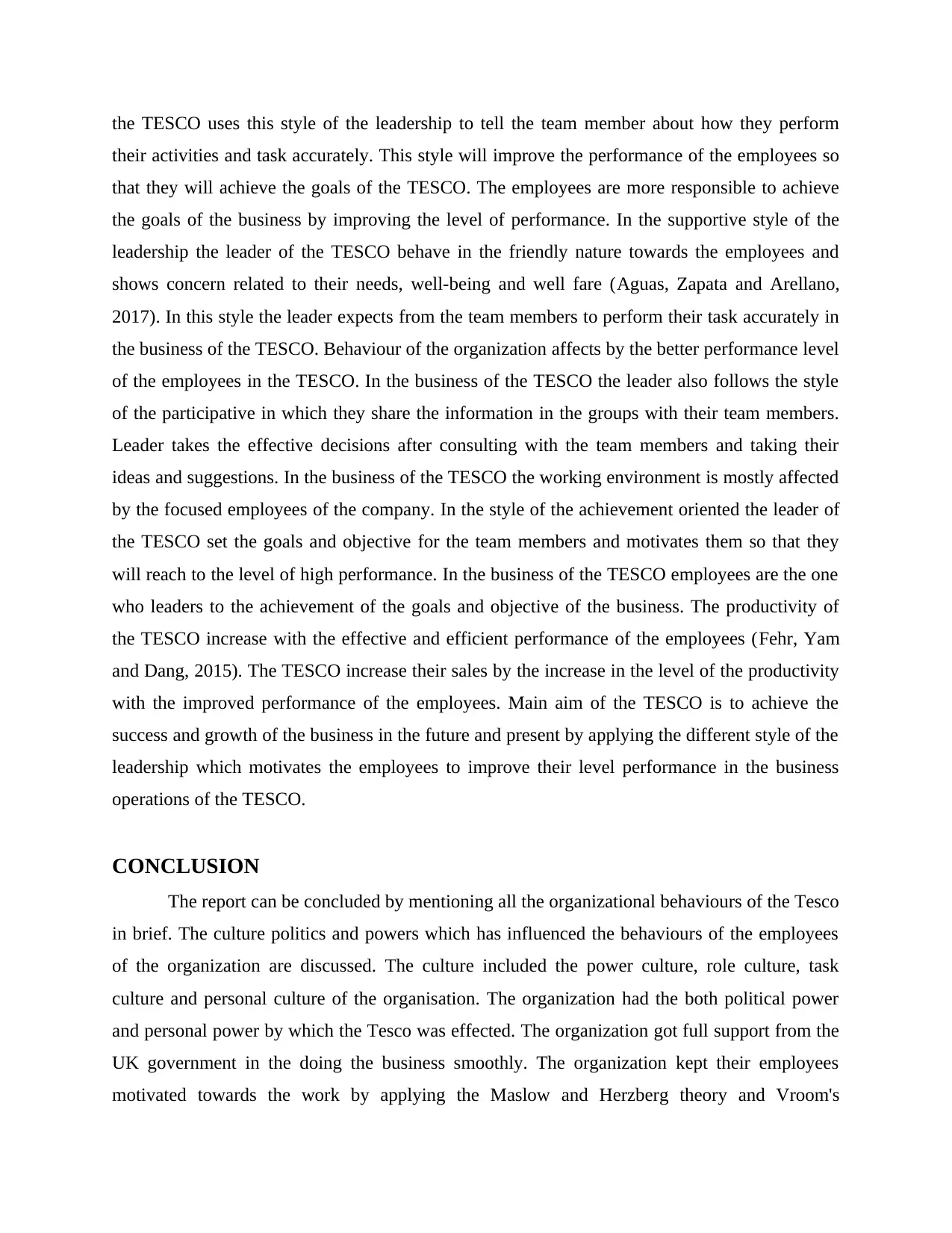
the TESCO uses this style of the leadership to tell the team member about how they perform
their activities and task accurately. This style will improve the performance of the employees so
that they will achieve the goals of the TESCO. The employees are more responsible to achieve
the goals of the business by improving the level of performance. In the supportive style of the
leadership the leader of the TESCO behave in the friendly nature towards the employees and
shows concern related to their needs, well-being and well fare (Aguas, Zapata and Arellano,
2017). In this style the leader expects from the team members to perform their task accurately in
the business of the TESCO. Behaviour of the organization affects by the better performance level
of the employees in the TESCO. In the business of the TESCO the leader also follows the style
of the participative in which they share the information in the groups with their team members.
Leader takes the effective decisions after consulting with the team members and taking their
ideas and suggestions. In the business of the TESCO the working environment is mostly affected
by the focused employees of the company. In the style of the achievement oriented the leader of
the TESCO set the goals and objective for the team members and motivates them so that they
will reach to the level of high performance. In the business of the TESCO employees are the one
who leaders to the achievement of the goals and objective of the business. The productivity of
the TESCO increase with the effective and efficient performance of the employees (Fehr, Yam
and Dang, 2015). The TESCO increase their sales by the increase in the level of the productivity
with the improved performance of the employees. Main aim of the TESCO is to achieve the
success and growth of the business in the future and present by applying the different style of the
leadership which motivates the employees to improve their level performance in the business
operations of the TESCO.
CONCLUSION
The report can be concluded by mentioning all the organizational behaviours of the Tesco
in brief. The culture politics and powers which has influenced the behaviours of the employees
of the organization are discussed. The culture included the power culture, role culture, task
culture and personal culture of the organisation. The organization had the both political power
and personal power by which the Tesco was effected. The organization got full support from the
UK government in the doing the business smoothly. The organization kept their employees
motivated towards the work by applying the Maslow and Herzberg theory and Vroom's
their activities and task accurately. This style will improve the performance of the employees so
that they will achieve the goals of the TESCO. The employees are more responsible to achieve
the goals of the business by improving the level of performance. In the supportive style of the
leadership the leader of the TESCO behave in the friendly nature towards the employees and
shows concern related to their needs, well-being and well fare (Aguas, Zapata and Arellano,
2017). In this style the leader expects from the team members to perform their task accurately in
the business of the TESCO. Behaviour of the organization affects by the better performance level
of the employees in the TESCO. In the business of the TESCO the leader also follows the style
of the participative in which they share the information in the groups with their team members.
Leader takes the effective decisions after consulting with the team members and taking their
ideas and suggestions. In the business of the TESCO the working environment is mostly affected
by the focused employees of the company. In the style of the achievement oriented the leader of
the TESCO set the goals and objective for the team members and motivates them so that they
will reach to the level of high performance. In the business of the TESCO employees are the one
who leaders to the achievement of the goals and objective of the business. The productivity of
the TESCO increase with the effective and efficient performance of the employees (Fehr, Yam
and Dang, 2015). The TESCO increase their sales by the increase in the level of the productivity
with the improved performance of the employees. Main aim of the TESCO is to achieve the
success and growth of the business in the future and present by applying the different style of the
leadership which motivates the employees to improve their level performance in the business
operations of the TESCO.
CONCLUSION
The report can be concluded by mentioning all the organizational behaviours of the Tesco
in brief. The culture politics and powers which has influenced the behaviours of the employees
of the organization are discussed. The culture included the power culture, role culture, task
culture and personal culture of the organisation. The organization had the both political power
and personal power by which the Tesco was effected. The organization got full support from the
UK government in the doing the business smoothly. The organization kept their employees
motivated towards the work by applying the Maslow and Herzberg theory and Vroom's
⊘ This is a preview!⊘
Do you want full access?
Subscribe today to unlock all pages.

Trusted by 1+ million students worldwide
1 out of 14
Related Documents
Your All-in-One AI-Powered Toolkit for Academic Success.
+13062052269
info@desklib.com
Available 24*7 on WhatsApp / Email
![[object Object]](/_next/static/media/star-bottom.7253800d.svg)
Unlock your academic potential
Copyright © 2020–2025 A2Z Services. All Rights Reserved. Developed and managed by ZUCOL.





